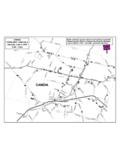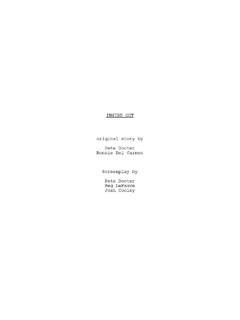Transcription of The Climategate Emails - Welcome to the Lavoisier Group ...
1 THE Climategate Emails . Edited and Annotated by John Costella The Lavoisier Group March 2010. About the Author John Costella was born in East Melbourne in 1966. After being expelled from Xavier College Kew in 1981, he went on to be dux of St. Kevin's College Toorak in 1984. and dux of Electrical Engineering Honours at the University of Melbourne in 1989. Having fallen in love with physics during second year, he went on to be dux of Physics Honours in 1990 and completed a PhD in theoretical physics in 1994. After spending a few years on the early rungs of the postdoctoral physics research ladder, during which time he became accustomed to distilling information from academic Emails , he decided that the life of an itinerant academic was not for him, so he took up school teaching instead, at the same time keeping up his interests in sub-atomic physics.
2 After teaching for eight years at Mentone Grammar and The Peninsula School, he took up a position as reliability engineer with the Department of Defence in 2006, analysing statistical data for Defence equipment. He then moved into the financial sector in April 2007, where he works as Data Manager and Senior Research Scientist for a leading investment firm. Dedication This booklet is dedicated to the memory of John Daly, Australia's pioneer global warming skeptic. John's first publication about global warming, The Greenhouse Trap, was published by Bantam Books in 1989.
3 It has stood the test of time ex- tremely well. John was a pioneer in the use of the Web to disseminate information that was relevant to this important debate and his website, Still Waiting for Greenhouse', showed the power which the Web afforded to those who were shut out of the main- stream media, but who had important information to make available to all who were involved in this historic debate. His sudden, untimely death in January 2004, at the age of 61, was a great loss to the skeptics' cause, and tributes to him flowed in from all over the world.
4 An obituary can be found on the Lavoisier Group website. The Climategate Emails edited and annotated by John Costella The Lavoisier Group March 2010. i 2010 John Costella and The Lavoisier Group Inc. A facsimile version of this publication, in PDF form, with hyperlinks, is available on the Lavoisier Group website: Layout and typesetting by Foxpress (a division of Fergco Pty Ltd). Body text set in Minion Pro 12 pt ii Foreword The Climategate Emails expose to our view a world that was previously hidden from virtually everyone.
5 This formerly hidden world was made up of a very few players. But they controlled those critical Intergovernmental Panel on Climate Change (IPCC) processes involv- ing the temperature records from the past, and the official interpretation of cur- rent temperature data. They exerted previously unrecognized influence on the peer review process for papers seeking publication in the officially recognised climate science literature from which the IPCC was supposed to rely exclusively in order to draw its conclusions.
6 The Climategate Emails demonstrate that these people had no regard for the tradi- tions and assumptions which had developed over centuries and which provided the foundations of Western science. At the very core of this tradition is respect for truth and honesty in reporting data and results; and a recognition that all the data, and all the steps required to reach a result, had to be available to the scientific world at large. There are two issues which now have to be addressed. The first is the damage which has been done to the standing of science as an intellectual discipline on which our civilisation depends.
7 The second is the status of the IPCC, since that institution is the source of scientific authority on which prime ministers and other political lead- ers rely to legitimise their statements about global warming. The IPCC was established by the World Meteorological Organisation (WMO) and the United Nations Environment Panel (UNEP) in 1988. From the very beginning its brief was to report on mankind's influence on climate change. The IPCC has published four assessment reports, in 1991, 1996, 2001, and in 2007. Every successive report has upped the ante, both in the confidence of their predic- tions of increasing global temperatures and rising sea-levels, and in the surety that mankind is responsible for continued warming.
8 The Climategate Emails originate from the University of East Anglia's, Climatic Re- search Unit, (CRU) founded by climatology pioneer Hubert Lamb. Tom Wigley, who was born and educated in Adelaide, was Director of the CRU until 1993 and was succeeded by Phil Jones, who is one of two lead players in this story. The other lead player is Mike Mann, from Penn State University. Mike Mann leapt from relative obscurity to international fame with his hockey stick , a graph of global temperatures from 1000 AD to the present, which was the showpiece at the iii launching of the 2001 IPCC Third Assessment Report in Shanghai in January 2001.
9 The hockey stick became a corporate logo for the IPCC , but because it rubbed out the Mediaeval Warm Period and the Little Ice Age from the historical record, it was subjected to a US congressional inquiry. Eventually it was shown that random data fed into the algorithms used by Mann to produce his hockey stick from bristle cone pine tree ring data, also yielded hockey stick results. In this annotated edition of the Climategate Emails , John Costella shows us how a very small cabal of climate scientists, based at the University of East Anglia and at Penn State University, were able to control the temperature record fed into the IPCC.
10 Reports and which comprised the foundation on which the whole global warming structure was based. The only data base which they could not influence was the satellite measured temperature data which John Christy and Roy Spencer, from the University of Alabama, had established from 1979 on. That this was a real conspiracy is beyond argument. The word conspiracy is used by the players themselves. In any conspiracy there is a tight inner core and then suc- cessive rings of collaborators, who accept the leadership of the central core.




